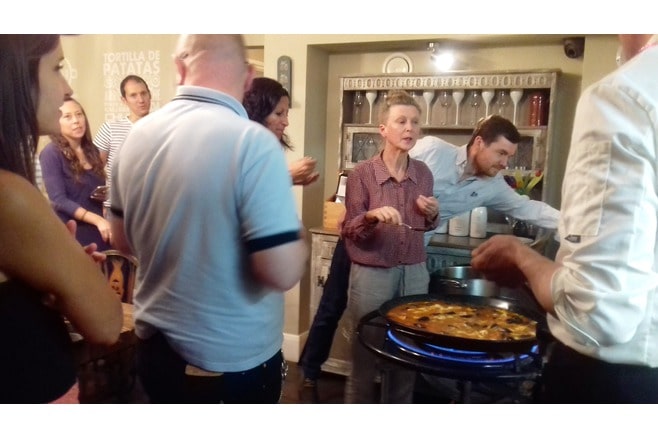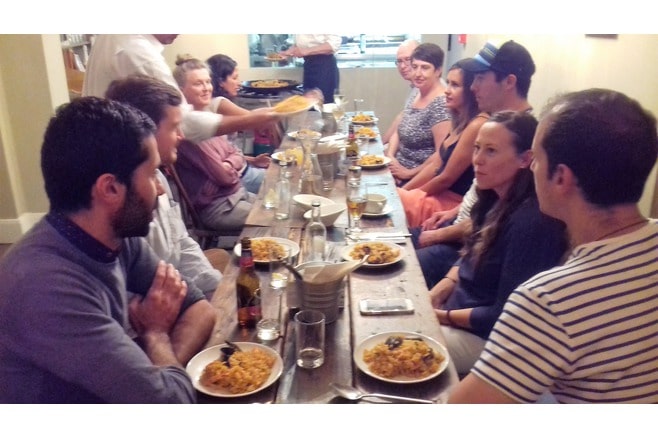“If you see a fluorescent yellow-rice paella, with the vegetables perfectly displayed in symmetrical order, run away. If it’s offered in a menu together with a big jug of sangria, keep on running”. Our Paella Masterclass chef is on a mission to make us experts, distinguishing between the tourist-trap, frozen paella and the real home-made paella.
He continues by making us observe and feel the authentic Valencian “bomba” round-grain rice and the Asian long-grain rice, important when it comes to differentiate between a real cook and a cheating amateur: the long-grain rice can boil for hours and hours and it never gets overcooked, whereas it takes a master to cook “bomba” rice to its point of perfection, not too “al dente”, not too overdone.
Did you know that the paella originated in Valencia, on the East Coast of Spain? It has now crossed all borders, becoming the most international Spanish dish. The paella is to Spanish cuisine what the pizza is to the Italian one. But ask a Valencian if you’d find good paella in say, for instance, the North of Spain, and they will clutch their head in their hands. Funnily enough, we have several Spaniards in the workshop: the two coming from Valencia and nearby Alicante used to have paella every Sunday when they lived in Spain, as you’d have Sunday roast in England. The rest of the Spaniards in the room, coming from other varied regions, would only eat it once every three or four months… that gives you an idea.
So, we’ve heated a bit of olive oil in the paella (confusingly, also the name of the essential pot in which you cook a paella. Because, assume it from now, you will never be able to make a proper paella in a regular frying pan). We’ve chopped red and green peppers and added them together with the squid and prawns.
We sip our wines for a couple of minutes while we listen to the valenciana and alicantina discuss in which of the two places the best paella is made. I smell a real sense of competition. I also smell the lovely aromas coming from the pan… sorry, the paella I should say.
Time to add the rice (one cup per person), chopped garlic and saffron. After a couple more minutes and sips of wine, we add the “tomate frito”, only to be found in Spanish shops according to our chef, as it´s nothing like the ones you can buy in English supermarkets. Finally, you pour the stock, previously made with prawn shells and fish bones: precisely two and a half cups of stock per cup of rice.
And this brings me to the metaphysical question of what the secret of a good paella is. Is it the proportion of water to rice? Or of rice to water? (Because believe it or not, for a proper valenciano both concepts don’t mean the same!). Is it the power of the hob? Is it moving the rice or keeping it still? Even our chef doesn’t seem to know where the secret lays, never in this life has he obtained exactly the same outcome. Sometimes he’s paid careful attention to all the steps in the recipe and obtained an average result, others he’s made an exquisite delicacy despite cooking while drunk. The process of making a paella seems to conceal some sort of magical chemical reaction and every Spaniard regards it with mystical respect.
And this brings me to the metaphysical question of what the secret of a good paella is. Is it the proportion of water to rice? Or of rice to water? (Because believe it or not, for a proper valenciano both concepts don’t mean the same!). Is it the power of the hob? Is it moving the rice or keeping it still? Even our chef doesn’t seem to know where the secret lays, never in this life has he obtained exactly the same outcome. Sometimes he’s paid careful attention to all the steps in the recipe and obtained an average result, others he’s made an exquisite delicacy despite cooking while drunk. The process of making a paella seems to conceal some sort of magical chemical reaction and every Spaniard regards it with mystical respect.
After 15 minutes of chatting, wine sipping and watching the rice boil, we turn off the heat and cover the paella for a further 5 minutes to let the rice absorb all the water and get a loose consistency. The smells are delicious, the 5 minute-wait seems eternal, I entertain my stomach with a few more sips of wine.
Finally, time to dig in! The wait was worth it! Mmmmmm what a beautiful explosion of flavours, what an amazing feast for the senses. By this time, I’m slightly tipsy, but still able to differentiate the excellent real paella that I have in front of me to the plastic-like impostors that I’ve had in tourist traps in Majorca.


